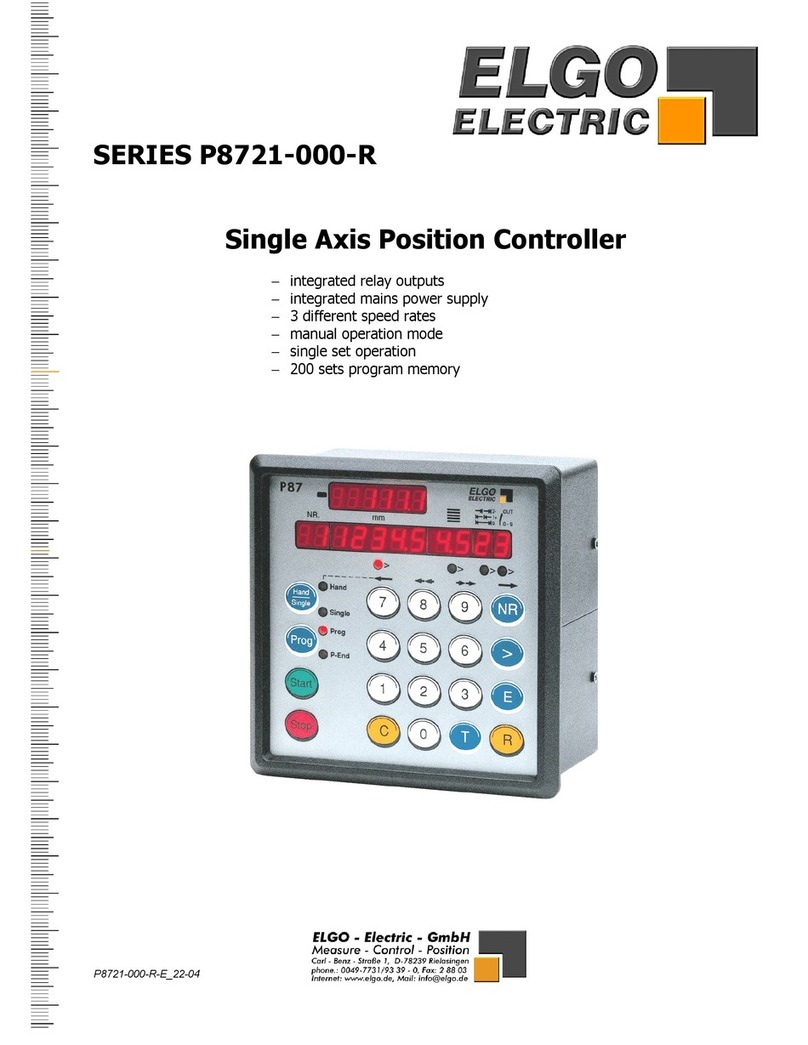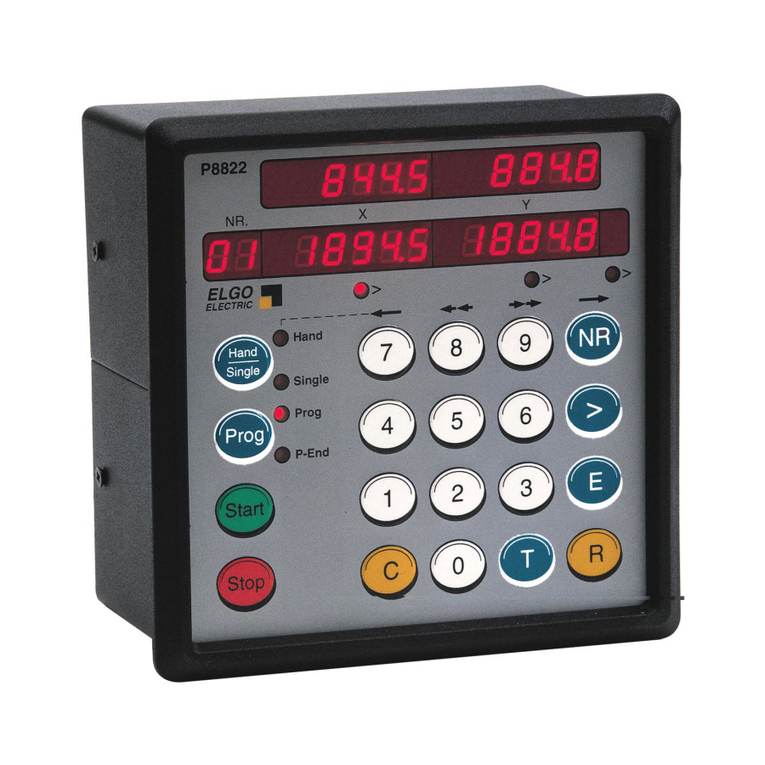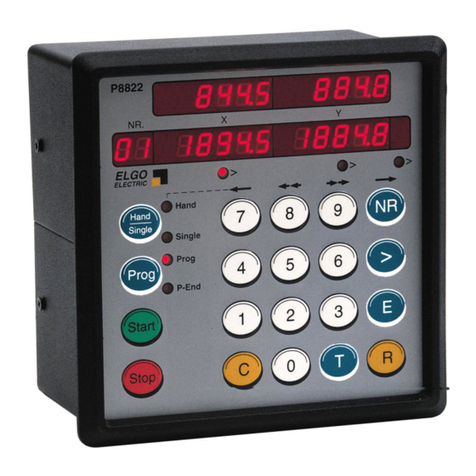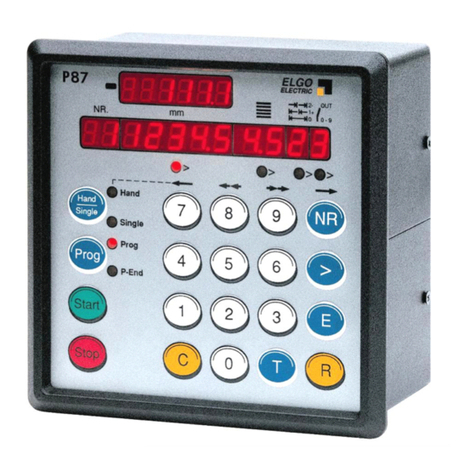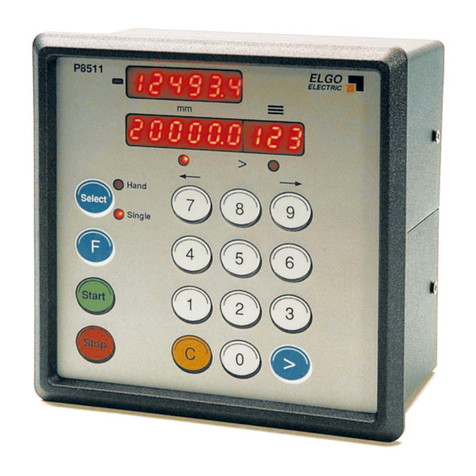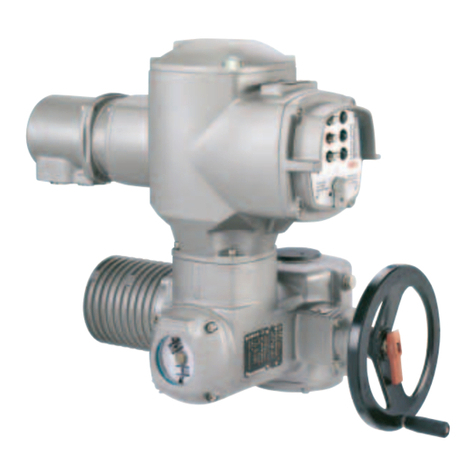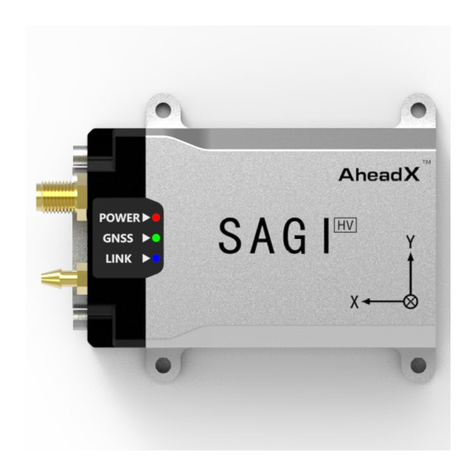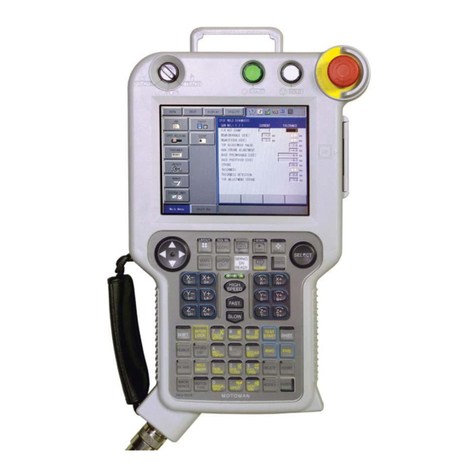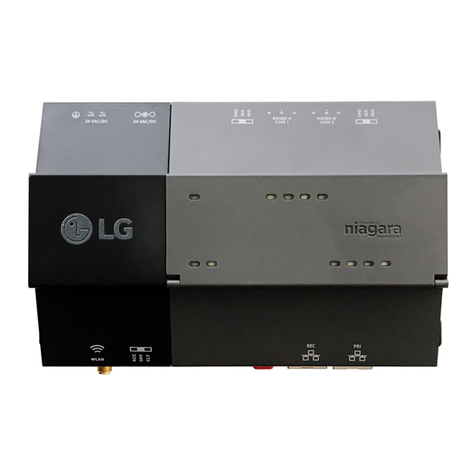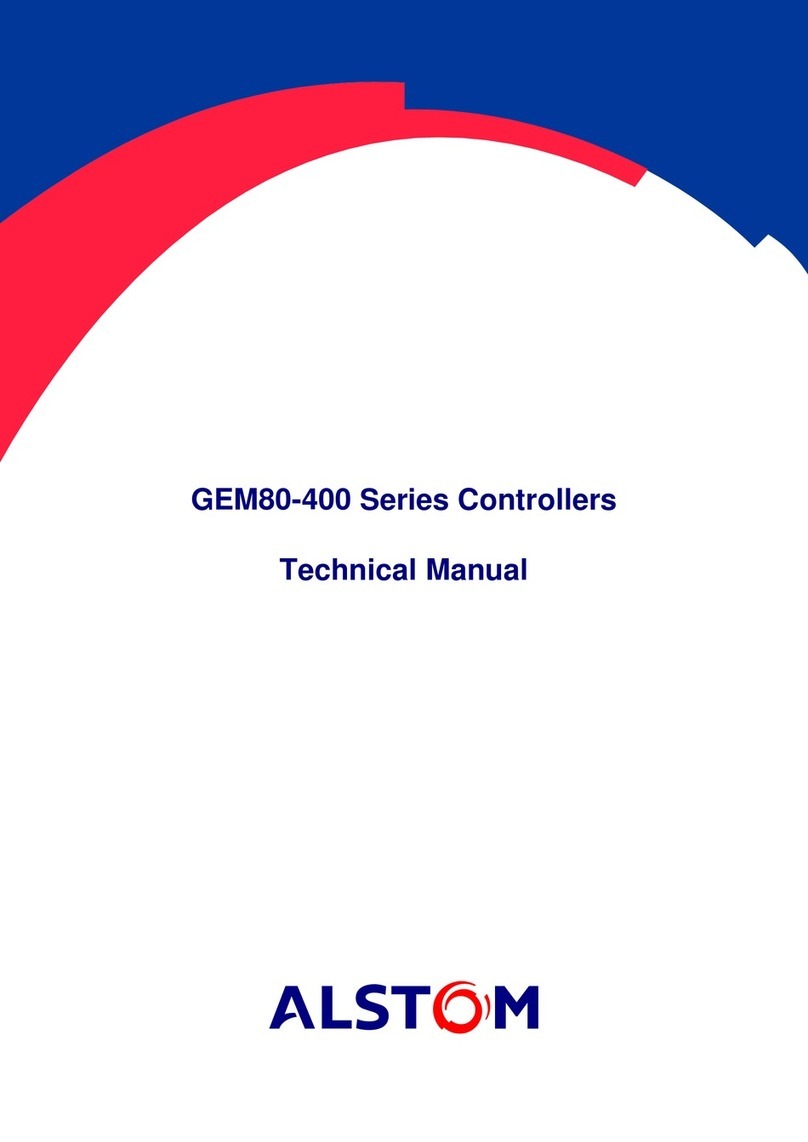ELGO Electric SERIES P8721-000-P User manual

SERIES P8721-000-P
ELGO - ELECTRIC Gerätebau und Steuerungstechnik GMBH
D - 78239 Rielasingen, Postfach 1130, Carl - Benz - Straße 1
P8721-000-P-SV001.V1.3 28/99
Single Axis Position Controller
−Closed loop Analogue with +/- 10v control and
2 or 3 switched speed operation
−200 Line programme
−Manual Operation
−Single Operation
−Auxiliary functions

2
1. SHORT DESCRIPTION 4
2. FUNCTIONS 5
2.1 Two speed operation 5
2.2 Three speed operation 5
2.4 Setting Datum 6
2.6 Encoder Monitoring 7
2.7 Quantity Counter 7
2.8 Auxiliary Functions 7
2.9 Fault Monitoring 8
3. FRONT PANEL 9
3.1 Functions of Display 9
3.2 Function of the Keypad 10
4. CONTROLLER IN OPERATION 12
4.1 Single Operation 12
4.2 Programme Operation (R8/4 = 0) 12
4.2.1 Selection of a Programme Block 12
4.2.2 Input of a Programme 13
4.3 Table Operation Mode (R8/4 =1) 13
4.3.1 Operation in Table mode 13
4.4 Hand Operation 14
5. REGISTER INPUT 15
5.1 Unlocking Registers by Security Code 15
5.2 Setting and Changing Register Values 15
5.3 Locking of Registers 16
6. REGISTER LIST 16
7. DESCRIPTION OF REGISTERS 18

4
1. Short Description
Whilst the P8721-000-P with option Analogue-output is specifically designed to provide
closed loop (Proportional, Integral, Differential) analogue control of 4 quadrant drives, it also
serves the purpose of operating as a 2 or 3 speed controller, as the P8721-000-R.
When used as a closed loop controller, it is essential that: -
1. A 4 quadrant drive – usually a high dynamic Servodrive, is used.
2. The drive is capable of accepting a +/- reference signal for direction, without a dead-band.
3. The Encoder is torsionally rigidly coupled to motor.
4. The mechanics of the machine are backlash-free.
Whilst it is possible to use lower specification drives and mechanics, it may then not always
be possible to achieve the performance and accuracy which is commonly expected of a
closed loop system.
When using a simple Inverter driven AC motor, it is essential to use the drive in F/V or FCC
mode, rather than the full Flux Vector (which tends to fight the position controller at low
speeds).
Physically, the P8721-000-P is plug compatible with the “old” 87P/P8721PID 2 or 3 switched
speed controller. It may also be more attractive when coupled to a PLC, when relays are not
required. It is necessary to use this model, when Auxiliary Functions are required.
As a 2 or 3 speed positioning system, it has the following features: -
Absolute and incremental positioning modes
Operation in Programme mode
Operation in Single positioning mode
Operation in manual, slow and fast mode
Quantity counting with completed output
Auxiliary outputs
Flexible multiplier for Display calibration
Datum setting routines
Tool offset compensation in incremental mode
Incremental error compensation
Backlash compensation
Tolerance window blanking
Encoder and drive failure detection
Maximum Encoder frequency 20 kHz
The unit is suitable for operation with any type of 2 or 3 speed bi-directional drive or any variable
speed drive with 1, 2 or 4 quadrant of control.

5
The performance and accuracy obtained is dependent on the type of drive chosen.
The outputs for stepped speed drives are transistors. These outputs can be configured in a
number of ways to suit all types of control circuits. Actual position is monitored by an incremental
Encoder. The power supply unit is external. If relays are required, an external relay card can be
provided.
The controller can be used to position machinery to any desired absolute position. Alternatively,
the controller can be used to feed material through a process.
As an Analogue closed loop controller, it has the additional features of :-
Analogue output +/- 10v
Top speed setting
Acceleration/Deceleration rate settings
PID term optimisation
Go to Datum routines
2. Functions
The P8721-000-P can be configured for switched speed or Analogue control.
2.1 Two speed operation
NB: R1 = R2 > R3 The value in Register 1 must be the same value as R2
slow point
F
as
t
(
an
d
s
l
ow
)
creep demand position
stop offset R 3
R 1
2.2 Three speed operation
NB: R1 > R2 > R3 The value in Register 1 must be larger than R2
demand position
fast
slow creep
stop offset
slow point
creep point R 3
R 2
R 1
NB: The stop offset is only effective when R8 = 1xxxxx.

6
2.3 Option Analogue +/- 10v Control (see Section 8 & 9 for full description)
The setting is effected using Registers R50 to R66
D
P
II - Limit
or Demand Speed
Time
Speed
2.4 Setting Datum
Datum can be set in a variety of ways. The method is selected in Register R8/3
R8 = xx0xxx Datum to R7
Closing input St 3 / 8 transfers the value set in R7
into Actual Position Display
R8 = xx1xxx Setting to Pre-set
Closing input St 3 / 8 transfers the Demand display
value into Actual Position Display
R8 = xx2xxx Go to datum at +ve end
R8 = xx3xxx Go to datum at –ve end
R8 = xx4xxx Datum with keypad alone
The value of R7 is transferred to Actual Display by
accessing R7, typing in value and then pressing E.
2.5.1 Operation of Go to Datum
After switch on of unit, initiating “Start” or “Datum” will cause the Axis to move in the
direction set in R8/3. The output “Going to datum” St5/7 is on.
When the Axis activates the respective end limit switch, it will stop for a time as set in
R10. It will then move slowly in the opposite direction. When it comes off the limit switch,
the Encoder marker input St1/8 is enabled. When the next marker pulse is detected, the
Axis stops and value of R7 is loaded into actual value display.
The going to datum output is now turned off.

7
The speeds for going to Datum are set as follows ;-
1. Analogue control
First phase (from start to hitting end limit)
Speed set in R67 (rpm)
Second phase (from reversal to marker pulse)
Speed set in R68 (rpm)
2. Switched speed control
First phase (from start to hitting end limit)
Speed set in R69
For Creep speed R69 = xxxxx0
For Slow speed R69 = xxxxx1
For Fast speed R69 = xxxxx2
Second phase (from reversal to marker pulse)
Speed is always equal to Creep speed
2.6 Encoder Monitoring
If after positioning is activated, no Encoder pulses are received after a time set in R19 (0.1
to 9.9 sec), positioning will be aborted and fault 01 will be displayed. Setting R19 to 0.0
sec, disables this feature.
2.7 Quantity Counter
Register R18/6 sets the method of counting whether adding or subtracting
R18 = xxxxx0 No Quantity counter
R18 = xxxxx1 Automatic subtracting
R18 = xxxxx2 Automatic adding
R18 = xxxxx3 Manual subtracting
R18 = xxxxx4 Manual adding
R18 = xxxxx5 Automatic add/subtract
R18 = xxxxx6 Manual add/subtract
With adding function, the counter starts from zero. When the set quantity is reached, the
quantity complete output will be pulsed. With subtracting function, counting from pre-set to
zero takes place. When zero is reached, the quantity complete output will be pulsed.
With add/subtract function, subtracting will take place if a pre-set value is entered. On
reaching zero, adding will ensue. The quantity complete output will still be pulsed at zero
count.
2.8 Auxiliary Functions
When operating in Programme mode, an auxiliary function can be selected on each
address line. The setting is 0 – 9. The outputs appear on St5/18 to 21, binary coded. The
output is set when the appropriate address line is selected and start given. It will remain
active on until the new line is selected and start activated.
When “Programme End” is reached, all Auxiliary outputs are reset.

8
2.9 Fault Monitoring
When a fault occurs, it’s number flashes in the Actual Position Display
Fault number 01 = Encoder failure detection
02 = -ve End limit active
03 = +ve End limit active
04 = Actual Position < min software limit (R13) Hand
Demand Position < min software limit (R13)Single
05 = Actual Position > max software limit (R14) Hand
Demand Position > max software limit (R14)Single
* 07 = External stop activated or wire break
08 = Number of Programme lines greater than 99
The fault message is cleared by pressing any button.
“07” also flashes if Stop on front panel is activated in middle of any move.
*NB: External stop =input must be linked before system can operate. Therefore, if
external n/c pushbutton is not fitted, then insert a permanent wire link.

9
3. Front Panel
3.1 Functions of Display
5
NR. mm
Prog
Start
Stop
4
Hand
Single
Prog
P-End
OUT
1 -
4
2-
1+
0
ELECTRIC
ELGO
>>>>
6
3
T
E
R
Hand
Single 89NR7
1
C
2
0
TYP P8721
()
sign symbol demand
position
actual
position Quantity
absolute/in
cremental
selection
Auxiliary function
Select single / manual
Select programme
operation
Start positioning
Stop positioning
LED 1-4
Address number selector
Cursor
Set programme end
Selector for parameter
Clear Reset
Adress
Address Window : Shows address line of Programme (or Register Nr)
Actual Position : Shows the Actual Position of the axis
Demand Position : Here you can enter the required position (or Register value)
Quantity Window : Shows how many pieces are left to be cut (or have been cut)
or How many incremental moves yet to be completed.
Absolute/Incremental: Defines Demand window 0 = Absolute dimension
Selection 1 = Incremental +ve
2 = Incremental -ve
Auxiliary Function : Input 0 to 9
LED “Hand” : Illuminates when button “Hand/Single” is pressed
twice. (Single also illuminated).
LED “Single” : Illuminates when button “Hand/Single” is pressed once
LED “Prog” : Illuminates when “Programme” is selected.
LED “P-End” : Illuminates when operating programme reaches the end.
LED 1 - 4 :Indicate which input window is being used. Selected by button >

10
5
NR. mm
Prog
Start
Stop
4
Hand
Single
Prog
P-End
OUT
1 -
4
2-
1+
0
ELECTRIC
ELGO
>>>>
6
3
T
E
R
Hand
Single 89NR7
1
C
2
0
TYP P8721
()
3.2 Function of the Keypad
Hand/ 1. Pressing once will select “Single”. (LED “Single” illuminates)
Single A Demand position can be entered. Using Cursor “>” Button enables quantity
to also be set. The “Start” button is only active when LED1 under Demand
window is illuminated. Output St5/5 is set to indicate Single is active.
2. Further pressing will select “Hand”. (LED “Hand” is also illuminated).
The Buttons 7 8 9 NR can be used for manual positioning at fast and creep
speeds in both directions. Output St5/6 is set to indicate Hand is active.
Prog Selects Programme mode.
Execute the desired programme by pressing “Start”.
(or Press R, to access Registers)
Start Starts positioning action
The Start Button is inhibited when programming or setting of Registers
is selected – also in Hand mode.
It will activate going to datum first time it is pressed after power up, if R8/3
Is selected to 2 or 3.
Stop Motion is stopped.
NR This Button is only active in Programme mode. It has the following functions.
1. Start the programming action. Thereafter, only the Cursor Button >
needs to be pressed to step to next input or data.
2. Checks existing programme. Pressing “NR” repeatedly scrolls through
the programme.
3. Selects the required address in Table mode (see section 4.3).

11
5
NR. mm
Prog
Start
Stop
4
Hand
Single
Prog
P-End
OUT
1 -
4
2-
1+
0
ELECTRIC
ELGO
>>>>
6
3
T
E
R
Hand
Single 89NR7
1
C
2
0
TYP P8721
()
>The Cursor Button selects the next data window sequentially. On
completion of a line, the next press will select the next Address line.
LED’s 1 – 4 indicate the selected Window.
EThis Button will :
1. Set the end of programme and reset the
Controller into Operation mode. This Button
should be pressed only when the last window
is selected (LED4).
2. Store the entered Register values.
RSelector for entry of Register values. Only active when “Prog” selected.
TReset Button : Resets all Demand Windows to zero in Programme mode.
CClears selected Demand Window value.
0 – 9 Numerical Keypad for data entry.

12
4. Controller in Operation
Switch on conditions: On switch on, the controller assumes the same conditions as at time
of switch off. The Actual position is memorised.
In “Hand” and “Prog”, the Demand Windows are set to zero.
In “Single” the Demand value is made to equal Actual value.
When automatic datum routine feature is selected,R8/3 = 2 or 3 the controller will not
operate, until the datum routine has been carried out.
4.1 Single Operation
In addition to Programme operation, a Single dimension can be set.
In Single operation, only an Absolute dimension and quantity can be entered. The
Windows “Abs/Incr” and “Aux” are inactive.
Press Hand/Single Till LED “Single” is illuminated alone.
Use Keys 0 – 9 To enter desired position.
Press > LED under Quantity Window illuminates.
Use Keys 0 – 9To enter desired quantity.
Press > LED under Demand Window illuminates.
Press Start The Axis moves to required position.
Enter new Position and Quantity and start as required.
4.2 Programme Operation (R8/4 = 0)
4.2.1 Selection of a Programme Block
The P8721 has a Programme memory of 200 Address lines. These can be divided into
several Blocks of equal quantity of lines (see Register R41). Each Block can store a
different Programme, which can be selected for operation, at will. If for example, 8 Blocks
of 25 Lines is set, selecting a Block higher than 8, will result in Block 8 being selected.
To select the required Block for operation.
Press Prog Selects Programme mode
Press R The Nr (Address) Window flashes.
Key in 40 40 appears in Nr Window (flashing).
Press > The previously selected Programme Block is displayed in
Demand Window.
Press C Clears value to zero.
Key in (say) 3 3 appears in Demand Window.
Press E Programme Block 3 is called up and sequence is ended.
Controller returns to Operation mode.
Now the Block can be used with the existing programme, or a new programme can be entered.

13
4.2.2 Input of a Programme
The required Programme Block is selected in accordance with section 4.2.1.
Press Prog Selects Programme mode
Press Nr “01” appears in Nr Window.
LED illuminates under Demand Window.
Press C Clears existing value.
Use Keys 0 – 9 To enter new dimension.
Press > LED illuminates under Quantity Window.
Press C Clears existing value.
Use Keys 0 – 9 To enter required quantity.
Press > LED illuminates under Abs/Incr Window
Press C Clears existing value.
Press : 0 Absolute Position
1 Incremental +ve move
2 Incremental –ve move
Press > LED illuminates under Auxiliary window
Press C Clears existing value
Use Keys 0 – 9 to enter required function (i.e. 10 max)
One line of programme is now complete. The Operator can now end programming or
continue to next Address line.
To end programming - Press E
To move to next line - Press >
4.3 Table Operation Mode (R8/4 =1)
If R8/4 is set to 1, then the Controller operates in 99 selectable address Table mode.
Programming is exactly the same as in 4.2.2.
4.3.1 Operation in Table mode
An address line of the stored programme can be called up and positioning effected to that
setting.
Press Prog Selects Programme mode
Press T Resets Controller.
Press Nr The Nr Window flashes “0”.
Key in (say) 58 “58” flashes in Nr Window.
Press > The programmed values of address 58 are displayed.
Press Start The Axis executes the demanded settings.

14
4.4 Hand Operation
Press T Resets demand windows to zero
Use the Button “Hand/Single” to select “Hand”. LED “Hand” illuminates.
Buttons 7 8 9 NR can be used to move the Axis forward and backwards at high and low
speeds (whilst the button is depressed). The remaining Buttons are inhibited in Manual
mode.
The Buttons have the following functions :
Button 7Slow Reverse
Button 8Fast Reverse
Button 9Fast Forwards
Button NR Slow Forwards
If a 3 speed drive is used, the Fast and Creep speeds are used. Physical direction of
movement can be reversed by setting of Register R64.
When operating in switched speed mode ( i.e. without Analogue output) the outputs
Fast/Slow/Creep/Reverse are set according to the button pressed.
When closed loop analogue control is used, the respective speeds are set in R60-63 in
rpm. The proportional analogue output voltage is given when the button is pressed.

15
5. Register Input
5.1 Unlocking Registers by Security Code
The values of Registers R1 to R97 can be changed after the Security Code 250565
has been entered into Register R98.
(Note that Register R40/R6/R7 are accessible without the need for the Security
Code).
Accessing Registers can only take place when the Controller is in Programme Mode.
In Register input mode, the decimal point is extinguished. All Registers are entered in the
Demand Position window
Use Button E to : a) Store Register values
b) End editing
Press Prog Controller is set to Programme mode. LED “Prog” illuminates.
Press R The Nr Window flashes
Press C Clears display to zero.
Key in “98” Value 98 appears in Nr Window with “8” flashing.
Press > The Demand Window shows “000000” without decimal point.
Press C Clears display to zero.
Key in “250565” Display shows 250565 (The Security Code).
Press E The Controller is now set to data entry mode. All Windows are
set to zero. Decimal point is reinstated.
5.2 Setting and Changing Register Values
Example: The Slowdown Point of 20.0 mm needs to be entered.
Assuming that Registers have been unlocked as above :-
Press R The Nr Window flashes.
Press C Clears display to zero.
Press 1 1 (flashing) is displayed in Nr Window i.e. Register 01.
Press > The existing value of R01 is displayed in Demand Window
Decimal point is extinguished.
Press C Clears old value to zero.
Key in “200” Window shows 200 (i.e. 20.0 mm).
Press EThe new value is memorised. All Windows are reset to
zero and Decimal Point is reinstated.
Any Register from 1 to 97 can be selected and changed in the above manner. If
sequential Registers are to be set, Press > twice instead of E and continue editing
Register by Register.
Press E on completion.
It is possible to run the Controller with Registers unlocked, e.g. having set the Stop offset
Register R03, you may now execute a “Single” move and then go back to edit R03.

16
5.3 Locking of Registers
Once all the values have been set, it is necessary to relock the Registers to avoid
accidental changes. There are two methods to do so.
a)Use Security Code
Press R
Key in 98
Press > 000000 is displayed
Press C Locks Registers
Press E
b) Switch off Controller.
6. Register List
Registers designated *can be changed without need of Security Code R98.
Register Function Resolution Suggested
initial setting Customer
01 Slow speed distance 0.1 mm 200
02 Creep speed distance 0.1 mm 100
03 Stop offset 0.1 mm 0
04 Backlash compensation 0.1 mm 50
05 Retract distance 0.1 mm 500
06 * Tool Width 0.1 mm 0
07 Datum value 0.1 m 1000
08 System Register 1 See para 7.8 000000
09 Position reached pulse 0.1 s 10
10 Backlash dwell time 0.1 s 10
11 Quantity reached pulse 0.1 s 10
12 Tolerance window 0.1 mm 0
13 Min software limit 0.1 mm 0
14 Max software limit 0.1 mm 500000
15 Software limit selection See para 7.15 000000
17 Display brightness 0-15 10
18 System Register 2 See para 7.16 000001
19 Encoder pulse monitor time 0.1 s 0
20 Decimal point See para 7.17 0
24 Backlash distance 2 0.1 mm 0
25 Fixed Position 0.1 mm 1000
28 System Register 3 000000
29 Time delay for Drive inhibit 0,1 sec 10
30 Programme end pulse 0,1 sec 10
31 Closed loop inhibit time in Hand 0,1 sec 10
33 Controller switch on condition 0,1 sec 0-2
34 Start time delay time 0,1 sec 10

17
Register Function Resolution Suggested
initial setting Customer
40* Programme Block selection See para 7.22 1
41 Number of lines in Prog Block 1-99 20
50 Speed UPM 1-10000 10
51 Accel/Decel revs/sec2 10
52 P term 1-3000 100
53 I term 1-1000 1
54 D term 1-1000 1
55 I limit 1-1000 1
56 Encoder edge multiplier 1,2,4 1
57 Encoder pulses per rev 1-10000 100
58 Stop-ramp selection 1-3 000000
60 Speed back hand slow Rpm 100
61 Speed back hand fast Rpm 1000
62 Speed forward hand fast Rpm 1000
63 Speed forward hand slow Rpm 100
64 Direction of manual buttons 0.1 0
65 Speed to fixed position Rpm 500
66 Accel for fixed position revs/sec2 5
67 Speed datum sequence phase 1 Rpm 100
68 Speed datum sequence phase 2 Rpm 10
69 Speed datum sequence with
relays phase 1 0,1,2 0
88 System Register 4 See para 7.42 000000
90 Button enable in service mode 0,1,2 0
94 Inch / factor multiplier 0.0to 9.99999 0
96 Encoder pulse multiplication
0.00001 to 9.99999 100000
97 Inch / mm selection 0,1,2,3 0
98 Security code 250565
99 Service - -
Logical sequence values such as these must always be present, regardless whether
3 speed, 2 speed or 1 speed drive is used.
P1 > P2 > P3 for 3 speed drive
P1 = P2 > P3 for 2 speed or 1 speed drive.

18
7. Description of Registers
R01 Slow speed distance
Distance to demand position at which the controller switches from high speed to slow
speed. The output high speed will be switched off.
R02 Creep speed distance
Distance to demand position at which the controller switches from slow to creep speed
R03 Stop offset distance
The over run distance can be programmed to compensate for distance from the switch-off
point of the motor to standstill. For exact positioning, the over run distance should be very
small (0.0 to 0.5 mm). Therefore the mechanical friction should be steady and the creep
speed should be very slow.
During commissioning, first set R12 to zero (to eliminate Tolerance window blanking),
then set the value of R03 to 0.0 and execute a number of moves in both directions. Note
the average overrun distance and then set R03 to that value. Then set R12 to suit.
NB: Stop offset is only functional when R8/1 = 1
R04 Backlash overrun
To correct for screw or pinion backlash, the Demand position should be approached from
one direction only. In positive direction therefore, the Demand position will be overrun by
the value of R4 and driven back at creep speed after a time delay of R10, to the Demand
position.
R05 Retract distance
There are different modes available in the P8721, selectable by Register R18/2.
If R18/2 = 0 Retract Position = Actual + R5
If R18/2 = 1 Retract Position = Value of R5
Whilst the input St3/8 is held on, the slide will move to the “Retract” position. On release of
input, slide will return to the original position. (Value 0)
When input St3/8 is activated, the slide moves to position as set in R5 but will not return to
original position on release of input. (Value 1)
R06 Tool offset compensation
This Register can be accessed without Security Code. When moving in incremental, it is
often the case that the subsequent function is a cut that removes part of the material.
Thus to cut the correct pre-set lengths, it is necessary to move the demanded distance
plus the “Tool Offset”. This feature is active in incremental mode only.

19
R07 Datum
This Register can be accessed without Security Code.
The Datum value is stored in this Register. The value is used in different ways, in
accordance with setting of P8/3. Input St3/8 initiates loading.
R08 System Register 1
This Register sets the basic operating functions of the unit.
Backlash
0 = no backlash compensation
1 = negative backlash comp
2 = positive backlash comp
3 = negative backlash in range of R24
4 = positive backlash in range of R24
Output Relay Config
0 = 3 speed operation
1 = Forwards + Backwards
2 = 2 speed Run + Reverse
3 = 2 speed separate output operation
4 = Fast only in reverse
5 = 3 speed Binary coded
6 = 3 speed operation forwards + backwards
Programme Memory
0 = Sequential Programme
1 = Table selection
Datum
0 = Datum to R7 by external input
1 = Datum to Demand by external input
2 = Auto-datum at +ve end
3 = Auto-datum at –ve end
4 = Datum to P7 by keypad
Display windows
0 = All windows in use
1 = Demand alone
2 = Demand & Quantity
3 = Demand + Quantity + A/I
Type of positioning
0 = Analogue positioning
1 = Fast/slow/stop mode

20
Output Configurations
These depend on setting of Register R8/5
Value 0 3 speed operation (Elgo standard default)
3 speeds selected by relays 1,2 & 3
output 4 sets direction reverse
OUTPUT ST5/ 1 2 3 4
Creep forwards X
Slow forwards X X
Fast forwards X X X
Creep reverse X X
Slow reverse X X X
Fast reverse X X X X
R1 = Run, R2 = Slow & R3 = Fast combined with Run.
If used with 2 speed, R2 or R3 = Fast.
Can also be used with single speed.
Value 1 2 speed operation
Independent outputs forward and reverse
Independent outputs fast and slow
OUTPUT ST5/ 1 2 3 4
Creep forwards X X
Slow forwards
Fast forwards X X
Creep reverse X X
Slow reverse
Fast reverse X X
R1 = Run forwards, R4 = Run reverse, R2 = Creep, R3 = Fast
Value 2 2 speed operation
Speed set by Relays 2 & 3
Direction set by Relay 4
OUTPUT ST5/ 1 2 3 4
Creep forwards X X
Slow forwards
Fast forwards X X
Creep reverse X X X
Slow reverse
Fast reverse X X X
R1 = Positioning (drive inhibit or brake)
R2 = Creep, R3 = Fast (both independent)
Other manuals for SERIES P8721-000-P
1
Table of contents
Other ELGO Electric Controllers manuals
Popular Controllers manuals by other brands
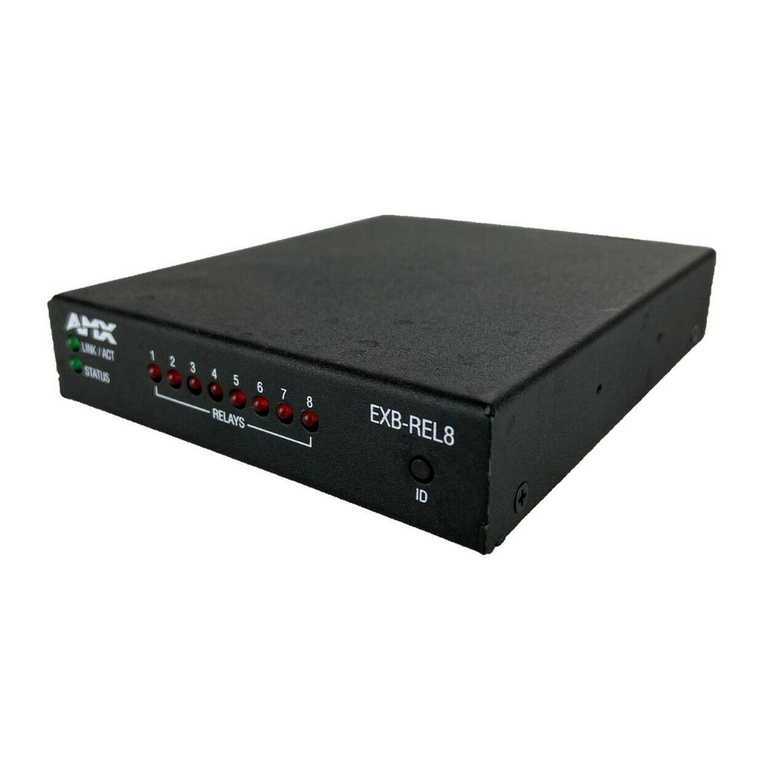
AMX
AMX AXB-REL8 instruction manual
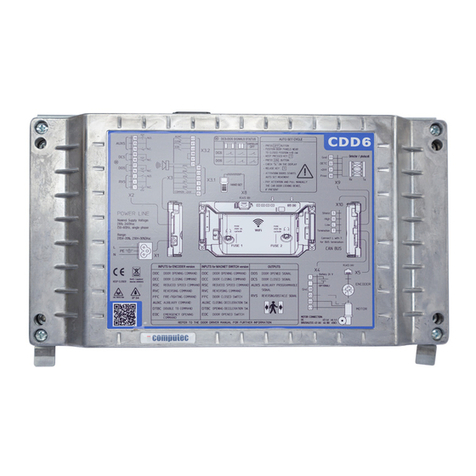
Computec
Computec CDD6 user manual
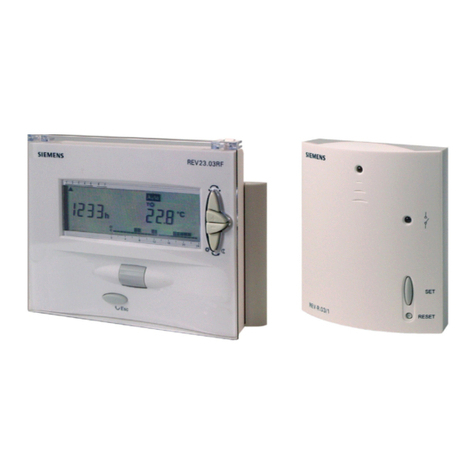
Siemens
Siemens REV23.03RF operating instructions

National Instruments
National Instruments NI PXI-8104 installation guide
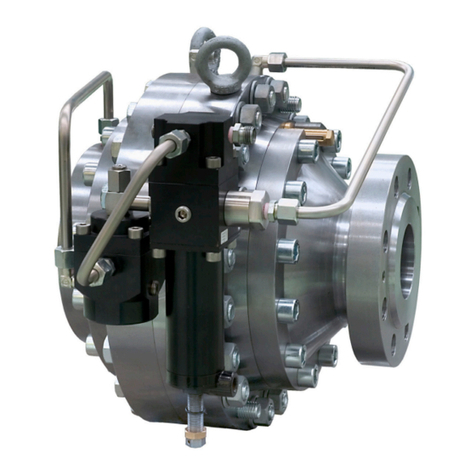
PIETRO FIORENTINI
PIETRO FIORENTINI ASX 176 TRANSLATION OF ORIGINAL INSTRUCTIONS

Data Technology
Data Technology 5150XL installation guide
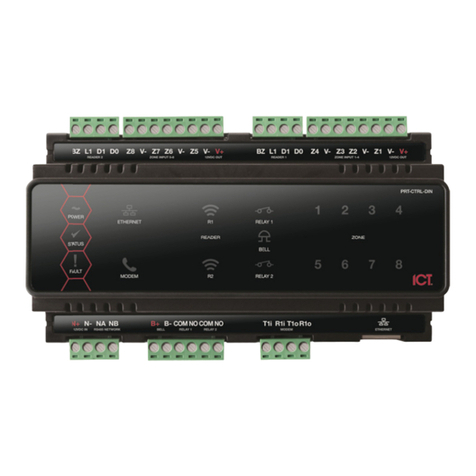
ICT
ICT Protege GX DIN Rail System Controller quick start guide

Festo
Festo MPPES 010 Series operating instructions
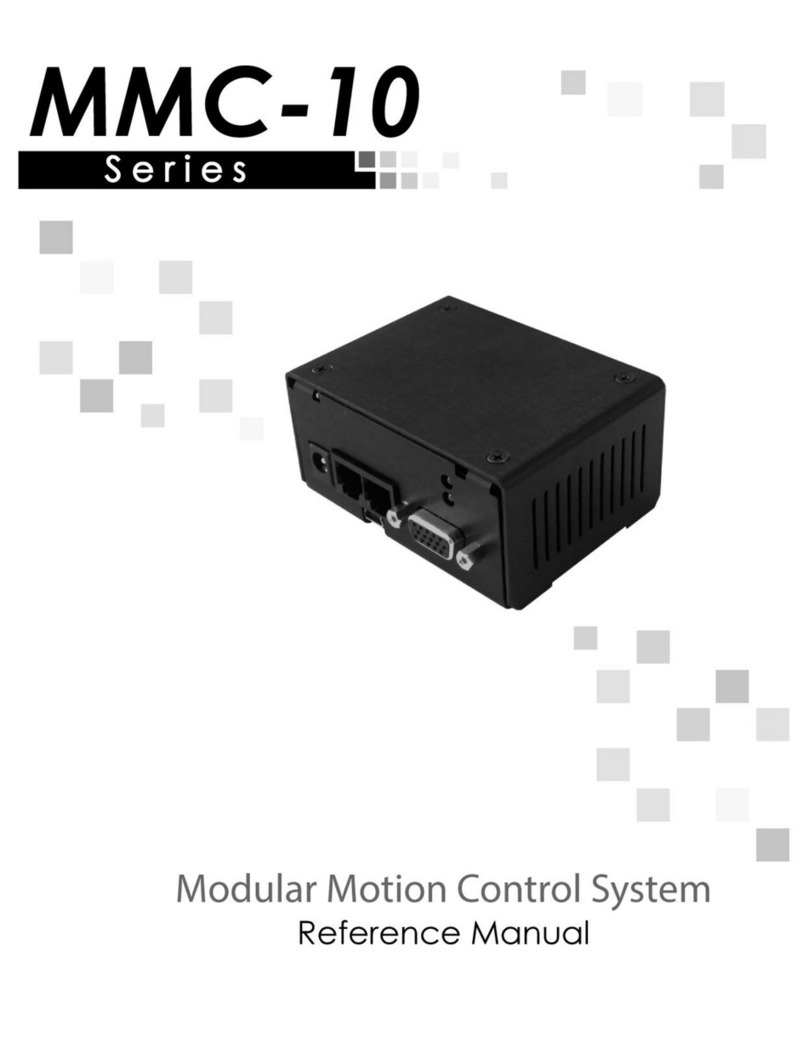
Micronix
Micronix MMC-10 Series Reference manual
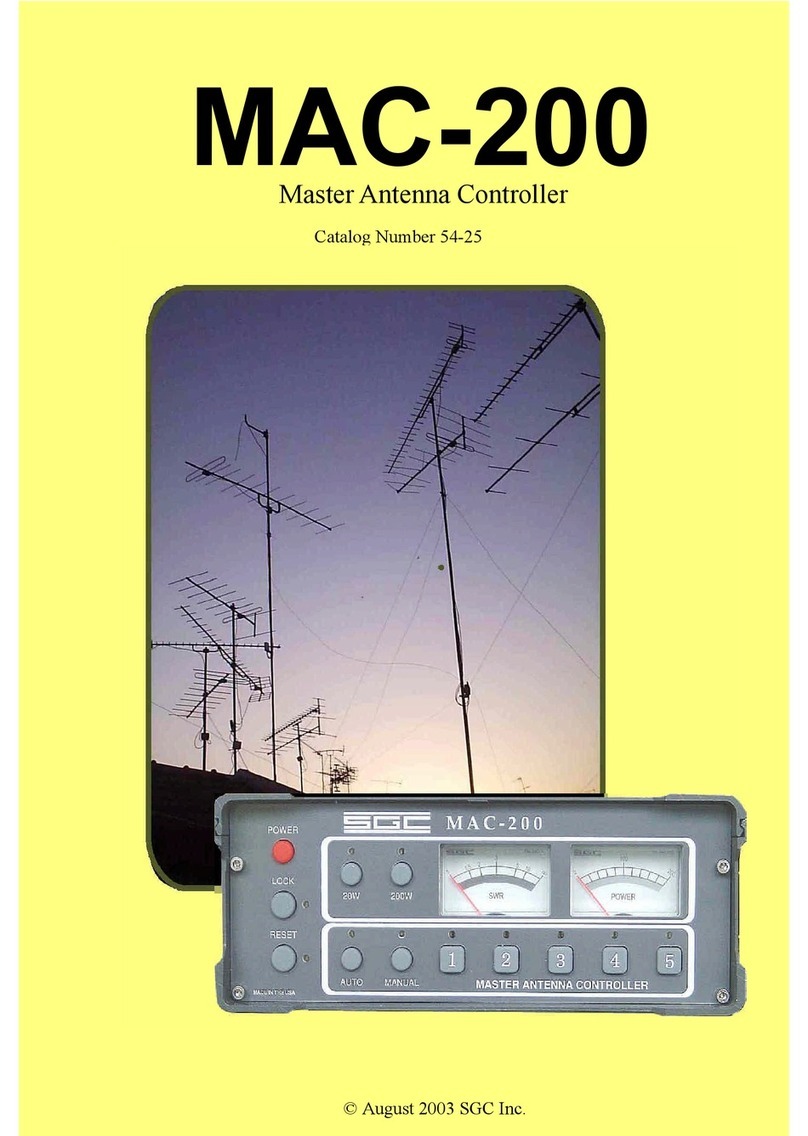
SGC
SGC MAC-200 operating manual
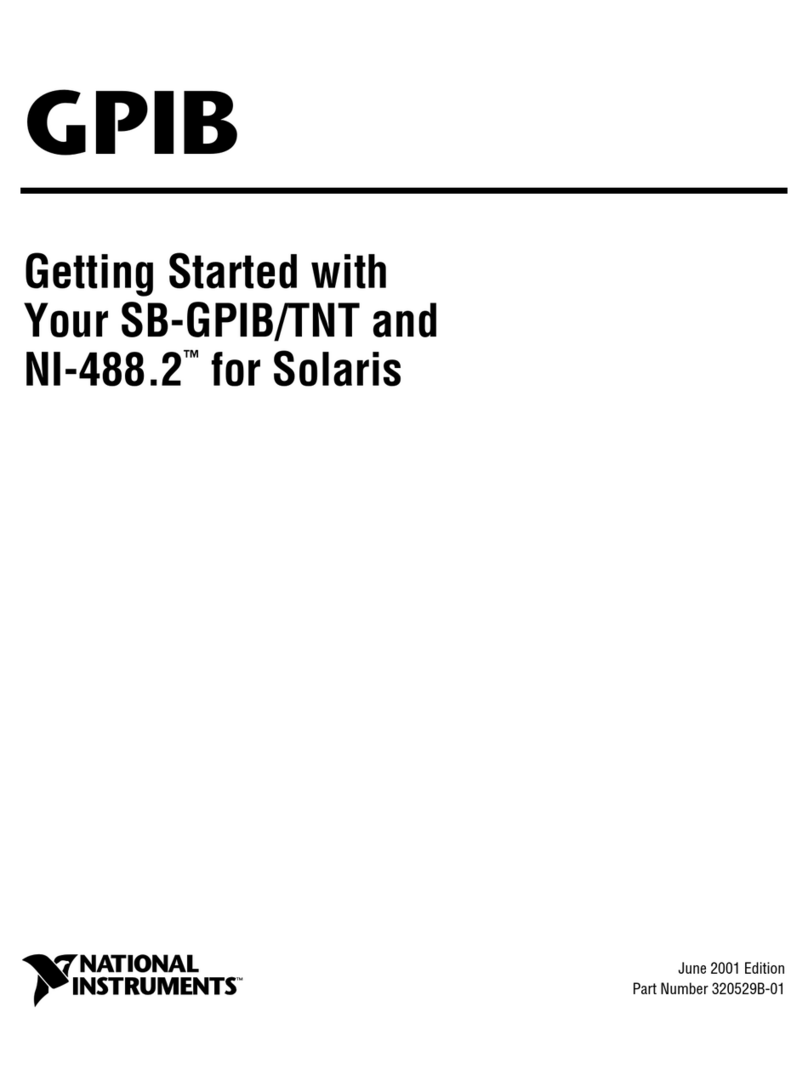
National Instruments
National Instruments SB-GPIB Getting started
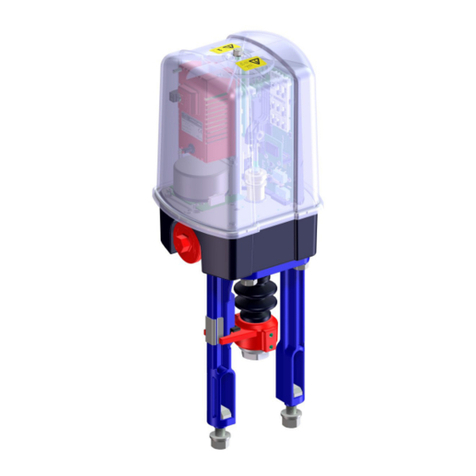
ARI
ARI ARI-PACO 2G Operating and installation instructions

